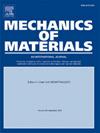Influence of the shape of cohesive zone models on the peeling of stiff film/soft substrate systems: A theoretical perspective
IF 3.4
3区 材料科学
Q2 MATERIALS SCIENCE, MULTIDISCIPLINARY
引用次数: 0
Abstract
Peel tests have been widely used to measure the interfacial properties of thin film/substrate systems. With the emergence of soft materials and structures, there is a growing need to characterize the interface of stiff film/soft substrate systems. The accurate prediction of their peeling behaviors relies on cohesive zone models (CZMs), but the influence of the shape of CZMs remains unclear. Herein, we propose a theoretical model based on the trapezoidal CZM to characterize the 90-degree peeling of stiff film/soft substrate systems, and this model can degenerate into those based on Dugdale’s and bilinear CZMs. We validate the theoretical solutions for different shapes of CZMs by finite element simulations, and reveal that the maximum peeling force () and the corresponding cohesive zone length () are significantly affected by the shape of CZMs. We further obtain the unified power scaling laws of and for different shapes of CZMs, where the scaling exponents depend on substrate elasticity and the shape of CZMs. By a simple extension of the present model, we find that the presence of a small initial interfacial crack can lead to a significant decrease of . When the initial interfacial crack is long, the influences of the substrate modulus, the shape of CZMs and the interfacial strength on can be ignored, and the peeling is governed by the interfacial fracture energy. With the present theoretical solutions, the interfacial strength and fracture energy of stiff film/soft substrate systems can be extracted simultaneously via 90-degree peel tests as long as the shape of CZMs is given and the initial interfacial crack is not very long. We expect that the present model can be extended to the case of arbitrary multi-linear CZMs, which can approximate arbitrarily shaped CZMs. These results can help us measure the interfacial properties of stiff film/soft substrate systems via peel tests, and understand the influence of the shape of CZMs on the interfacial fracture from a theoretical perspective.
内聚区模型的形状对硬膜/软基体系剥离的影响:一个理论视角
剥离试验已被广泛用于测量薄膜/衬底系统的界面特性。随着软材料和软结构的出现,人们越来越需要表征硬膜/软基板系统的界面。其剥离行为的准确预测依赖于粘聚带模型,但粘聚带形状对剥离行为的影响尚不清楚。在此,我们提出了一个基于梯形CZM的理论模型来描述硬膜/软基体系的90度剥离,该模型可以退化为基于Dugdale和双线性CZM的理论模型。通过有限元模拟验证了不同形状czm的理论解,发现最大剥离力(Pmax)和相应的粘聚区长度(lCZmax)受czm形状的显著影响。进一步得到了不同形状czm的Pmax和lCZmax的统一幂标度定律,其中标度指数取决于衬底弹性和czm的形状。通过对模型的简单推广,我们发现小的初始界面裂纹的存在会导致Pmax的显著降低。当初始界面裂纹较长时,基材模量、czm形状和界面强度对Pmax的影响可以忽略,剥离受界面断裂能控制。在现有理论解的基础上,只要给定czm的形状,并且初始界面裂纹不是很长,就可以通过90度剥离试验同时提取硬膜/软基体系的界面强度和断裂能。我们期望该模型可以推广到任意多线性czm的情况,可以近似任意形状的czm。这些结果可以帮助我们通过剥离试验测量硬膜/软基体系的界面性能,并从理论角度了解czm形状对界面断裂的影响。
本文章由计算机程序翻译,如有差异,请以英文原文为准。
求助全文
约1分钟内获得全文
求助全文
来源期刊

Mechanics of Materials
工程技术-材料科学:综合
CiteScore
7.60
自引率
5.10%
发文量
243
审稿时长
46 days
期刊介绍:
Mechanics of Materials is a forum for original scientific research on the flow, fracture, and general constitutive behavior of geophysical, geotechnical and technological materials, with balanced coverage of advanced technological and natural materials, with balanced coverage of theoretical, experimental, and field investigations. Of special concern are macroscopic predictions based on microscopic models, identification of microscopic structures from limited overall macroscopic data, experimental and field results that lead to fundamental understanding of the behavior of materials, and coordinated experimental and analytical investigations that culminate in theories with predictive quality.
 求助内容:
求助内容: 应助结果提醒方式:
应助结果提醒方式:


